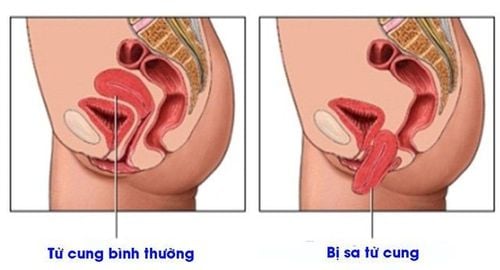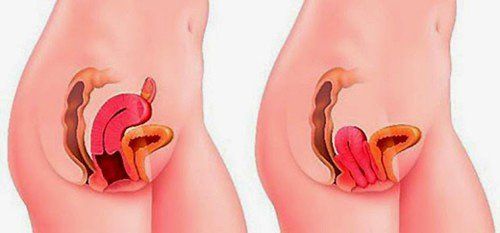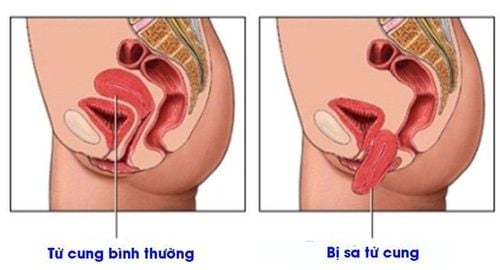This is an automatically translated article.
Uterine prolapse can cause the uterus to prolapse, protrude the vaginal area, the uterus is exposed outside the vagina, the body is inside the vagina and the worst is that the entire uterus is completely prolapsed outside the vagina.
1. Genital prolapse
Genital prolapse, also known as uterine prolapse, occurs when the pelvic floor muscles and ligaments stretch and weaken, inadequately supporting the uterus. The uterus descends into the vaginal canal. Pelvic stenosis is one of the skeletal defects that lead to organ prolapse and uterine prolapse.
Genital prolapse is common in people aged 40-50 years and older, quite common in Vietnamese women who work hard, give birth a lot, give birth unsafely. Genital prolapse is often referred to as uterine prolapse or uterine prolapse. Although it is not a life-threatening disease, it greatly affects women's activities and labor, especially hindering the husband-wife relationship and urinary disorders such as urinary incontinence or difficulty in urination. urine.
2. Levels of genital prolapse

Hình ảnh sa sinh dục
Genital prolapse has three different levels, if at the mildest level, there are only a few clinical manifestations. At the second level, also known as the intermediate level, at this time, the uterus has fallen deeper, even the body of the uterus is inside the vagina and there may be cases where it is exposed outside the vagina. In the most severe cases, the entire uterus is completely prolapsed outside the vagina.
1st degree genital prolapse: Uterine prolapse, protruding vaginal area.
Prolapse of the anterior vaginal wall (combined with bladder prolapse) Posterior wall prolapse (combined with rectal prolapse) Grade 2 genital prolapse: The uterus is exposed to the vagina, the body is inside the vagina.
Prolapse of the anterior vaginal wall (combined with bladder prolapse) Posterior wall prolapse (combined with rectal prolapse) Grade 3 genital prolapse: The entire uterus is completely prolapsed outside the vagina.
Anterior vaginal prolapse (combined with bladder prolapse) Posterior wall prolapse (combined with rectal prolapse)
3. Signs of genital prolapse
Depending on each person, depending on the degree of prolapse, a new or a long prolapse, a simple prolapse or a combined lesion, signs such as: Discomfort, a feeling of heaviness in the area of your mouth. , in the lower abdomen, especially when standing, but when lying down, the upper feeling is gone.
Sometimes there is a feeling of wanting to give birth because the veins in the perineum are congested, and at the same time because the pressure in the abdominal wall on the perineum has weakened; or pain in the lower back.
If accompanied by bladder prolapse, there are signs: Difficulty urinating, urinary incontinence, urinary incontinence when laughing loudly, when coughing strongly or when shivering, often urinating not all urine, so the bladder is easily inflamed causing painful urination . In case of a lot of bladder prolapse, it is very difficult to urinate at first, must use your fingers to push the bladder up and in to urinate. Sometimes patients come to the hospital because of acute urinary retention.
If accompanied by rectal prolapse, there is a feeling that there is still not enough stool in the rectum, possibly constipation. Many people have genital prolapse but their periods are normal and there is still a chance of pregnancy. These women are more prone to miscarriage and premature delivery. Bleeding, vaginal discharge a lot due to cervical inflammation, rubbing, making it difficult for the patient to walk.
4. How to prevent genital prolapse

Sau khi đẻ thì các bà mẹ không nên lao động quá sớm và làm việc quá nặng, tránh căng thẳng
Women should go to qualified medical institutions for reproductive health care, which are staffed by professional doctors and midwives. Modern life, so it is not advisable to lay a lot, lay too early or lay thick.
Performing tricks must ensure sufficient conditions, correct indications and correct techniques. Do not let labor last too long, do not push for too long..
Injuries to the genital tract must be repaired with proper technique and quality.
After giving birth, mothers should not work too early and work. too heavy, avoid stress. Try to practice abdominal muscle exercises to make the waist toned better. In addition, the pelvic floor muscles and pelvic muscles are also strengthened, making the uterus push higher or in other words, the uterus will return to normal
Eat enough fiber, vegetables, avoid Constipation because when constipated, having to strain during defecation is also the cause of weak muscles as well as very easy genital prolapse.
It is necessary to detect and treat early chronic diseases that cause frequent increase in intra-abdominal pressure (permanent constipation, prolonged cough...) that are the causes of genital prolapse.
Currently, there are many effective surgical treatment methods for genital prolapse. Depending on the extent of the examination, the doctor will prescribe medical or surgical intervention. At Vinmec International General Hospital, robotic laparoscopic surgery is the optimal method for any genital prolapse. With this method, the patient will have advantages such as non-recurrence of the disease, preservation of the uterus and resolution of accompanying urinary symptoms of the disease.
Da Vinci robot made in the USA is an advanced, sophisticated, modern robot with 4 arms that almost perfectly simulate human hand movements, meeting the needs of surgery with requirements. tallest. Thanks to this feature, surgical robots can penetrate narrow, deep and difficult to reach locations, solving the limitations of classical open and laparoscopic surgery. With outstanding advantages: Safety, minimizing the risk of complications and surgical infection, pain relief, less blood loss, quick recovery, ensuring aesthetics, the robot can be used for most surgeries. cases must be treated with endoscopic methods especially in cancer treatment.
Please dial HOTLINE for more information or register for an appointment HERE. Download MyVinmec app to make appointments faster and to manage your bookings easily.













